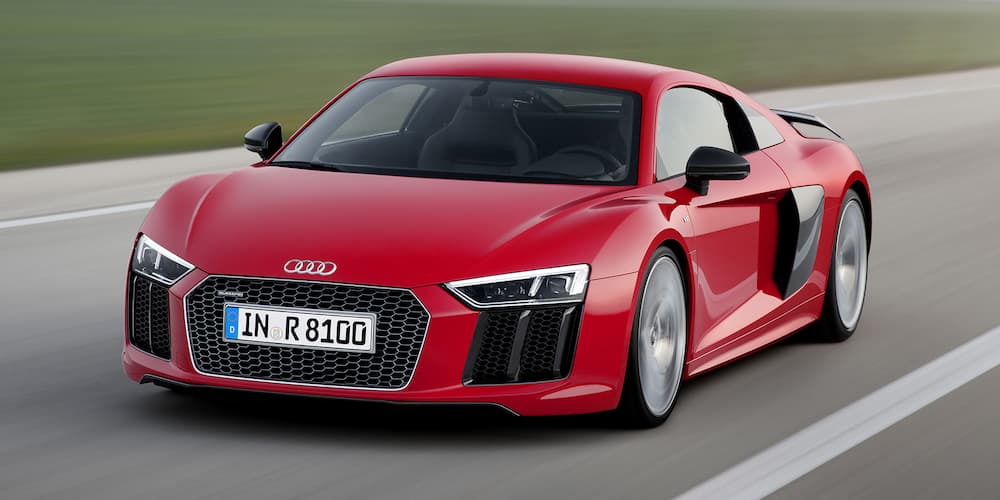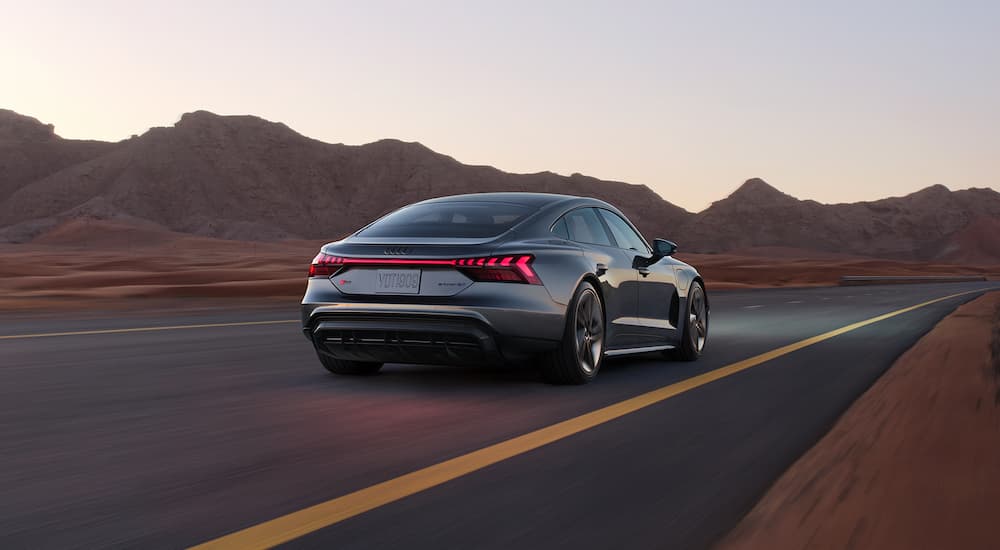One of the biggest stories in recent years is well-known car models heading to the scrapyard in the sky. Back in November 2022, it was announced that the 2023 model year of the Audi R8 would be its last. The second-generation R8 Type 4S was never a huge seller—total numbers lagged well behind rivals like the Porsche 911, Mercedes-AMG GT, and even the closely related Lamborghini Huracan—but it had developed a cult following for its V10 supercar performance and exotic style.
With the discontinuation of the Audi R8, the Audi e-tron GT has been thrust further into the spotlight. First debuting in late 2021, this all-electric vehicle is steadily gaining steam. In fact, it outsold the R8 five times over in 2023. Although it is categorized as an executive car, many enthusiasts have wondered if the Audi e-tron GT could be the unofficial successor to the R8. But does it stack up? We decided to put the e-tron GT and R8 head-to-head to see where this newer EV stands in comparison to the now-defunct supercar.
V10 vs Electric Motors
The obvious place to start is what these vehicles are packing. An electric motor may be completely different from a gas engine, but they’re measured the same way: horsepower and torque. The baseline 2024 Audi e-tron GT in either the Premium Plus or Prestige trim offers 522 hp and 472 lb-ft of torque from a pair of electric motors, which far outshines rival EVs like the BMW i5 and Mercedes EQE. As for the 2023 Audi R8, it comes standard with 562 hp and 406 lb-ft of torque from its 5.2L V10 engine.
Of course, what would an Audi be without some upgrades? The e-tron GT RS brings serious heat with 637 hp and 612 lb-ft of torque, making it the most powerful vehicle in the Audi lineup. As for the R8, its GT variant got a mild bump to 602 hp and 413 lb-ft of torque.
All e-tron GT models come with a two-speed automatic transmission for the rear motor. And what a launch it gives—the e-tron GT RS can go from 0-60 mph in 2.9 seconds while the standard e-tron GT does so in 3.6 seconds. The second-generation R8 replaced the balky manual transmission in the first generation with a seven-speed dual-clutch that can do 0-60 mph in a reported 3.4 seconds.
Overall, we give a slight edge to the 2024 e-tron GT here. The 2023 Audi R8 has more horsepower in the base trim and gives you shifting control. However, the e-tron GT has significantly more torque across the board, and its high-end RS trim sports 35 more horsepower than the best R8 model.
On-Road Performance
Next up is the behind-the-wheel experience. The 2024 Audi e-tron GT already has a reputation as an exciting car to drive. Along with that eye-popping acceleration we mentioned, the vehicle is smooth and stable, with all-wheel drive coming standard, as expected for an Audi. It also has a special cooling system to prevent battery overheating (and the related performance drop-off).
Optional features include all-wheel steering and an air suspension to make the handling truly out of this world. Unlike many other electric vehicles, the e-tron GT uses traditional two-pedal driving. This makes it drive and feel more like a traditional gas-powered vehicle. One downside is that it can understeer a bit in extreme conditions.
The 2023 Audi R8, on the other hand, is known as one of the more easy-going supercars. That’s a blessing and a curse. It makes the R8 excellent as a high-end everyday driver, but when it comes to winding roads and track days, the R8 won’t hit the mark quite as well as other performance vehicles. It has a direct steering system with a solid feel.
Rear-wheel drive is standard on all models, with quattro all-wheel drive available as an upgrade. The limited-edition R8 GT adds a Torque Rear mode, which gives you seven levels of adjustable traction control and allows you to easily drift the car. The biggest advantage of the R8 is that you can order it as a convertible to enjoy sunny days. Still, we’ll chalk another win up to the e-tron GT for its performance-driving improvements.
Driving Range
We’re not talking about golf here—we’re talking about how far you can go on a full tank of fuel or battery. According to EPA estimates, the range for the 2023 Audi R8 is as follows:
- Audi R8 Coupe RWD: 328 miles
- Audi R8 Coupe quattro: 290 miles
- Audi R8 GT or Spyder RWD: 359 miles
- Audi R8 Spyder quattro: 316 miles
By comparison, the 2024 Audi e-tron GT and e-tron GT RS both have an EPA-estimated 249 miles of range on a full charge. Audi claims it takes 22.5 minutes to charge the e-tron GT battery from 5% to 80% capacity using its 270 kW maximum charging speed. In terms of how far you can drive and how long you must stop, the Audi R8 has a clear edge. However, according to EPA estimates, you could save an estimated $3,000 a year in fuel costs with the e-tron GT. That could add up even when talking about six-figure supercars.
The Practical Side
The final thing we wanted to look at was what each car is like in the cockpit. The 2024 Audi e-tron GT is a four-seat, leather-upholstered sedan designed to bring along up to four friends or family members. That being said, the slope-back roof makes the rear seats a tight squeeze. As for media and connected services, all trims come with separate instrument and infotainment displays, Apple CarPlay, Android Auto, USB ports, and Bang & Olufsen speakers.
You also get basic safety features like lane departure warning, side cross-traffic alert, automatic emergency braking, and parking sensors. The Prestige and RS add a 360-degree camera and a heads-up display. Our biggest beef is that beginning with 2024 models, Audi requires owners to pay for many onboard features—including navigation, streaming, charging station location, and weather updates—after the first six months.
The 2023 Audi R8 has a more minimalist two-seat interior. Don’t confuse that for ugly or outdated, though. It feels refined on the inside with leather or recycled fabric upholstery in your choice of colors, patterns, and stitching. The sports seats are shaped for long-driving comfort while holding you securely in place. With the R8 GT, you also get carbon fiber trim.
With less space on the inside, Audi combined the digital instrument cluster and infotainment system into a single high-resolution display. It has many of the same connectivity features as the e-tron GT and adds an onboard Wi-F hotspot, but it only comes with a five-speaker sound system standard, though you can upgrade to a Bang & Olufsen option. Safety features are sparse, with only parking sensors and automatic high beams as standard offerings.
The puny cargo area in the R8 is also a concern. It’s eight cu.ft. in the hardtop and a mere four cu.ft. in the convertible—enough room for one standard-size suitcase. In comparison, the e-tron GT has 9.2 cu.ft. of cargo space in the trunk and an additional 1.8 cu.ft. in the frunk where the engine would normally be. Apart from safety assistance, this category goes down as a draw in our book. Each vehicle has its advantages and problems, and it comes down to which features are most important to you.
The Verdict
After going over each vehicle with a fine-toothed comb, it’s obvious why Audi didn’t announce a replacement for the R8—it already had one. The 2024 e-tron GT blends supercar-like performance with modern EV design to make a “super sedan.” There are still a few areas that can be tweaked, but it has a lot going on for the 21st-century car fanatic. Even so, we’re sorry to see the Audi R8 go. It had a special place in the segment and was ideal for anyone who wanted to show off an exotic side as part of their everyday driving. We’re just happy that Audi, if ever so slyly, came up with a worthy vehicle to pass the torch to.






